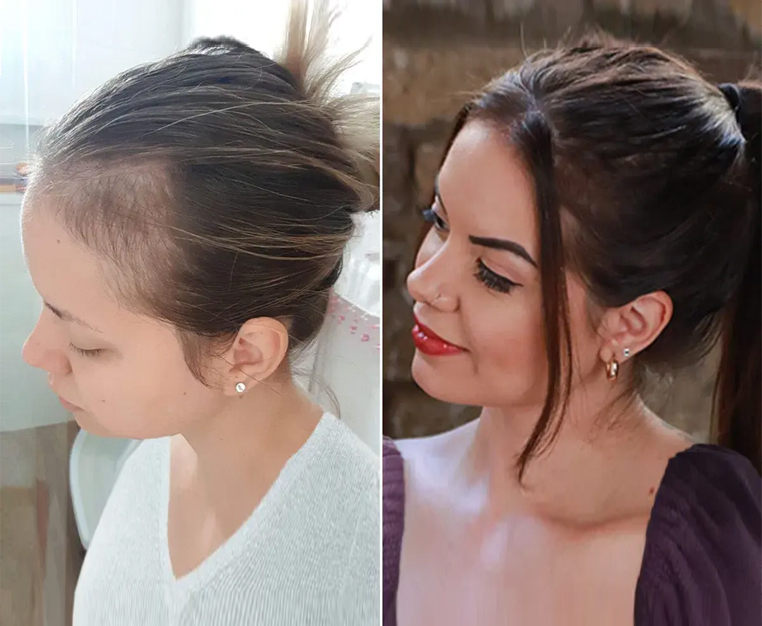Years of extensions, weaves and braids are what did it for supermodel Naomi Campbell. But while she is perhaps the most celebrated person to suffer from traction alopecia, she is by no means on her own. While it’s a condition that can occur in anyone regardless of gender or colour, it is one that women of African heritage seem to experience in greater numbers than any other group. This article will consider some of the reasons for that, as well as detailing steps that can be taken to combat the condition.
Keep scrolling to get the facts about traction alopecia and women of colour!
What is Traction Alopecia?
Traction alopecia is a type of hair loss that occurs when there is prolonged tension or pulling on the hair follicles. It is often associated with hairstyles that put excessive strain on the hair, such as tight ponytails, braids, weaves, cornrows or extensions. When these hairstyles are worn repeatedly over time, they can lead to hair breakage and eventually cause the hair follicles to become damaged, resulting in hair loss.
Caught at an early stage, traction alopecia is reversible. If left undiagnosed or untreated, however, it can result in permanent damage to the hair follicles and scarring alopecia. Many academics and clinicians believe that traction hairstyles are a risk factor for central centrifugal cicatricial alopecia, a specific form of scarring hair loss that primarily affects women of African descent. More research is needed on this, however.
Are Black Women at Greater Risk?
Women of colour may be more susceptible to traction alopecia for several reasons. One of those is hair texture. Black women often have hair with a tighter curl pattern or increased curliness. This hair type is generally more prone to breakage and damage when compared with straight or wavy hair.
Hairstyling is another issue. In many communities of colour, traction styles like braids, extensions and cornrows are traditional choices, popular with all age groups. Cultural and societal norms within these communities may place a higher emphasis on these specific hairstyles, making it more difficult to switch to a different look.
It’s important to note that not all women of colour will experience traction alopecia, and the condition can affect individuals of any ethnic background.
Preventing Traction Alopecia
Preventing traction alopecia involves adopting healthy haircare practices, including avoiding styles that rely on excessive tension. While these styles won’t do excessive damage if worn only for short periods, problems can arise if you don’t mix them up with looser styles to give your hair follicles time to recover.
Another good haircare tip to adopt is to handle your strands gently when styling, brushing, or detangling. Don’t simply tug harder whenever you encounter knots and tangles! Instead, take time to straighten out your hair. Use wide-toothed combs or brushes with soft bristles to minimise breakage. The softer approach will help counterbalance some of the damage caused by traction hairstyles.
On a similar theme, avoid excessive heat styling, chemical treatments and harsh hair products that can further damage your hair. Regularly massaging the scalp can help improve blood circulation to the hair follicles and promote hair growth.
Keeping your hair well-moisturised and conditioned is an important step in improving its overall strength and resilience. If you notice signs of excessive hair loss or thinning, don’t put off getting it checked. Fun fact: staring at your hair in the mirror every morning and pulling faces whenever you discover another thin spot won’t fix the problem. Consult a hair specialist who can provide proper diagnosis and treatment options.
Medications
Minoxidil, an over-the-counter topical medication, can be applied directly to the areas affected by traction alopecia to stimulate hair growth. Always follow the instructions provided and consult with a healthcare professional before using any medications. In some cases, corticosteroid injections may be prescribed by a dermatologist. These injections help reduce inflammation in the affected area and promote hair regrowth.
It’s worth noting that treatment effectiveness may vary depending on the severity of traction alopecia and individual factors. If you’re experiencing persistent hair loss or have concerns, it’s recommended to consult with a hair specialist who can provide a tailored treatment plan based on your specific situation.
Conclusion
Remember, the information provided here is for general knowledge. We always recommend that you consult with a healthcare professional or hair specialist for personalised advice and guidance regarding your specific situation.
Vinci Hair Clinic can help when it comes to contacting a hair specialist. We are one of the world’s leading hair restoration organisations and, over the years, we have built a reputation for delivering excellence as standard. We offer a free, no-obligation consultation to all our new clients. You can visit one of our many clinics or send us your photographs via WhatsApp. Get in touch to schedule your appointment!


